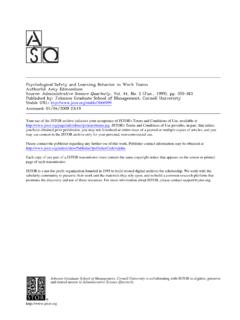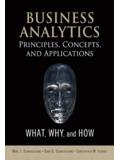Transcription of An Introductory Course in Theoretical English Grammar
1 1 Vilnius Pedagogical UniversityDepartment of English PhilologyLaimutis ValeikaJanina Buitkien An Introductory Course in TheoreticalEnglish GrammarMetodin mokymo priemon auk t j mokykl studentams20032 Vilnius Pedagogical University, 2003 Leidinys svarstytas ir rekomenduotas spaudai U sienio kalb fakultetoAngl filologijos katedros pos dyje 2003 03 12, protokolo Nr. 5 Leidinys svarstytas ir rekomenduotas spaudai U sienio kalb fakultetoTarybos pos dyje 2003 03 13, protokolo Nr. 4 Recenzentai: doc. dr. Gra ina Rosinien , doc. dr. Daiva Verikait . 7 Traditional Grammar .. 8 Traditional Grammar in Ancient 8 Traditional Grammar in Ancient Rome .. 9 prescriptive 10 Non-Structural descriptive 13 Structural descriptive Grammar .. 1 4 Transformational Generative Grammar .
2 2 0 The Explanatory Power of Non-Structural descriptive , StructuralDescriptive and Transformational-Generative Grammar (by way ofsumming up) .. 25 Structural Features of Present Day English .. 3 0 Grammatical Classes of Words .. 3 5 The Principles of Classification as Used by prescriptive Grammarians .. 35 The Principles of Classification as Used by Non-Structural 36 The Principles of Classification as Used by Structural 36 The Classification of Words in Post-Structural Traditional Grammar .. 39 The 4 2 The Semantic Classification of Nouns .. 44 The Grammatical Category of Number .. 46 The Grammatical Category of Case .. 49 The Category of Gender .. 53 The Category of Determination .. 56 The 6 3 Semantic Features of the Verb .. 63 Finite Forms of the Verb.
3 71 The Category of Person .. 71 The Category of Number .. 73 The Category of Tense .. 744 Introductory .. 74 Present Tense .. 77 Past Tense .. 78 The Problem of Future Tense .. 79 Absolute and Relative Tenses .. 82 The Category of Aspect .. 84 The Category of Mood .. 88 The Category of Voice .. 91 The Category of Order (the Perfect) .. 97 The Function of the Category of Order .. 98 The Perfective Form and the Pefective Aspect .. 102 Non-Finite Forms of the Verb .. 103 The 104 The Verbal Features of the 105 The Nounal Features of the 107 The 108 The 110 The 116 The Adverb .. 122 The 125 The 1335 PrefaceThis book is intended for university-level students of English who havetaken a practical Grammar Course and are now ready to take a Course intheoretical aim is to provide the students with a brief survey of Englishmorphological problems in the light of present-day want to express our gratitude to Assoc.
4 Prof. Algimantas Martink nas,Dean of the Faculty of Foreign Languages, for the congenial atmosphere andencouragement, to the staff of the Department of English Philology, to Gra ina Rosinien and Assoc. Prof. Daiva Verikait for reading themanuscript and contributing valuable ValeikaJanina Buitkien 7 IntroductoryFor a start, let us try and answer the question what is Grammar ? The termgrammar is derived from the Greek word grammatik , where gram meantsomething written. The part tik derives from techn and meant art. Hencegrammatik is the art of writing. Since its appearance in ancient Greece theterm has undergone considerable modifications. In ancient Greece and ancientRome the terms grammatik and grammatica respectively denoted the wholeapparatus of literary study .
5 In the middle ages, Grammar was the study of England, this conception of Grammar continued until the end of the 16thcentury. Latin Grammar was the only Grammar learned in schools. Until thenthere were no grammars of English . The first Grammar of English , Bref Grammarfor English , written by William Bullokar, was published in 1585. The mostinfluential Grammar of English (published in 1762) was R. Lowth s ShortIntroduction to English Grammar . It started the age of prescriptive a prescriptive grammarian, Grammar is rules of correct usage; its aim wasto prescribe what is judged to be correct rather than to describe actual new, modern understanding of Grammar appeared only by the end of the19th century, when the period of scientific ( descriptive ) Grammar began. Todescriptivists, Grammar is a systematic description of the structure of a the appearance of structural descriptive linguistics, Grammar came tomean the system of word structures and word arrangements of a given languageat a given time.
6 To transformational-generative grammarians, who are an off-shoot of structural descriptive linguistics, Grammar is a mechanism forproducing sentences. Thus the actual definition of Grammar is determined bypragmatic factors. If we wish to learn to speak and write, we will focus on thesystem of rules that underlie a given language, and if we wish to describe thestructure of a language, we will focus on the units that make up the languageand their relations, and if we wish to understand how speakers of a givenlanguage produce and understand sentences, we will focus on the nature of therules used. Hence we can speak of two types of Grammar : practical andtheoretical. Practical Grammar gives practical rules of the use of the linguisticstructures while Theoretical Grammar gives an analysis of the structures in thelight of general principles of linguistics and the existing schools and , English grammars, according to their general aims andobjectives, can be divided into: a) traditional ( prescriptive and non-structuraldescriptive): b) structural descriptive and c) GrammarTraditional Grammar in Ancient GreeceFormally, traditional Grammar is the type of Grammar as it was before theadvent of structural linguistics.
7 Two periods of traditional Grammar could bedistinguished: 1) prescriptive (pre-scientific) and 2) descriptive (scientific).Traditional Grammar has its origins in the principles formulated by thescholars of Ancient Greece and Rome in the works of Dionysius Thrax,Protagoras, Plato, Aristotle, Varro, and Thrax (c. 100 ) was the first to present a comprehensivegrammar of Greek. His Grammar remained a standard work for thirteencenturies. Thrax distinguishes two basic units of description the sentence(logos), which is the upper limit of grammatical description, and the word,which is the minimal unit of grammatical description. The sentence is definednotionally as expressing a complete thought . The constituents of the sentencewere called meros logos, parts of the sentence.
8 Thrax distinguished onoma(noun) class words, rhema (verb), metoch (participle), arthron (article),ant nymia (pronoun), pr thesis (preposition), epirrh ma (adverb), andsyndesmos (conjunction). He reunited the Stoic common and proper nounsinto the single noma (noun) class; he separated the participle from the adjective was classed with the noun, as its morphology and syntax weresimilar to those of noun was defined as a part of the sentence inflected for case andsignifying a person or a thing; the verb as a part of the sentence without caseinflection, but inflected for tense, person, and number, signifying an activity orprocess performed or undergone; the participle as a part of the sentence sharingthe features of the verb and the noun; the article as a part of the sentenceinflected for case and preposed or postposed to nouns; the pronoun as a part ofthe sentence substitutable for the noun and marked for person.
9 The prepositionas a part of the sentence placed before other words; the adverb as a part of thesentence without inflection, in modification of or in addition to the verb; theconjunction as a part of the sentence binding together the discourse and fillinggaps in its defined class of words is followed by a statement of the categoriesapplicable to it. Thrax refers to them as parep mena. By parep mena hemeans grammatically relevant differences in the forms of words which includeboth inflexional and derivational categories. To illustrate this, consider thenoun. Thrax distinguishes five such categories of the noun:91)G nos (gender): masculine, feminine, neuter;2)E dos (type): primary or derived;3)Sch ma (form): simple or compound;4)Arithm s (number): singular, dual, or plural;5)Pt sis (case): nominative, vocative, objective, genitive, parep mena of the verb included mood, voice, type, form, number,person, tense, and conjugation.
10 Three basic time references are distinguished:present, past, and future. Phrax s set of parts of speech has undergone onlyminor modifications and is still very much in use today. The main omission inthis Grammar is the absence of any section on syntax. Syntax was dealt with,rather extensively, by Appolonius Dyscolus. Appolonius based his syntacticdescription on the relations of the noun and the verb to each other and of theremaining word classes to these two. The achievements of the Greek scholarslie in devising and systematizing a formal terminology for the description ofthe classical Greek language, a terminology which, through adaptation to Latinand later on adopted from Latin by other languages, has become part andparcel of the grammatical equipment of the linguistics of our Grammar in Ancient RomeRoman linguistics was largely the application of Greek thought to theLatin language.






